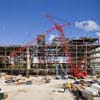New Case Lends Support To Agency Discretion Under CEQA

May 2012
Number 20
The California Environmental Quality Act (CEQA) requires a lead agency to consider the environmental impacts of a proposed project. Generally, when considering such impacts, a lead agency uses as the baseline the conditions in the vicinity of the project as they exist at the time environmental analysis is commenced. This approach of using existing conditions as the baseline is supported by the CEQA Guidelines. (Cal. Code Regs., tit. 14, §§ 15000 et seq.) Based on these guidelines, courts have generally required the existing condition baseline, including in decisions from California's Fifth and Sixth District Courts of Appeal in recent years.
A new case holds that it may be proper to use projected future conditions to measure environmental impacts, if the decision to do so is supported by substantial evidence. In Neighbors for Smart Rail v. Exposition Metro Line Construction (Apr. 17, 2012) __ Cal.App.4th __ (2012 WL 1297501), the Court of Appeal for the Second District considered an environmental impact report (EIR) prepared in connection with construction of a light rail line between downtown Los Angeles and Santa Monica. To analyze traffic and air quality impacts, the lead agency utilized projected future baseline conditions for the year 2030. The lead agency found that the existing conditions, including current population and traffic levels, did not provide a reasonable baseline for the purpose of determining whether traffic and air quality impacts of the project would be significant in the future. Project opponents filed a lawsuit, contending that this approach violated CEQA by using hypothetical future conditions as the baseline.
The court disagreed, holding that in a proper case, when supported by substantial evidence, use of projected conditions may be an appropriate way to measure the environmental impacts that a project will have on traffic, air quality, and greenhouse gas emissions. The court pointed out that since the project would not even begin to operate until 2015 at the earliest, its impact on traffic and air quality conditions that exist today would yield no practical information to decision makers or the public. The court's decision was based in part on the notion that population growth in the Los Angeles area is inevitable, and was thus not just a hypothetical future condition.
In the opinion, the court also disagreed with the contrary decisions from the Fifth and Sixth District Courts of Appeal. Since this creates a split among California's appellate courts, review by the California Supreme Court may be on the horizon.
In a further show of support for agency discretion when considering CEQA issues, the Neighbors for Smart Rail court also upheld the EIR against numerous other challenges. For example, the court rejected contentions that the EIR's proposed measures to mitigate environmental impacts were inadequate and improperly deferred the formulation of mitigation measures in the areas of parking, noise and vibration, public safety, and construction. The court based this conclusion on the fact that the mitigation measures set specific performance standards for implementation, and were not uncertain or speculative. Other mitigation measures were upheld despite the fact that they were alleged to be within the responsibility and jurisdiction of other public agencies. The court also upheld the EIR's failure to contain detailed consideration of a particular project alternative, concluding that the agency was not required to consider every conceivable alternative, but that a rule of reason governs consideration of alternatives. Further, the court upheld the agency's decision not to recirculate the EIR based on new information, including a further study of impacts, added after the draft EIR was circulated, finding that none of the added information disclosed a new substantial environmental impact, or a substantial increase in the severity of an impact of the project. The court noted that, if anything, the information added served to lessen the severity of an impact.
Neighbors for Smart Rail is an encouraging decision for lead agencies, as it strongly upholds the agency's discretion when undertaking a CEQA analysis. However, we recommend using caution in relying too heavily on its holding since it involved specific facts relating to a long-term transportation infrastructure project, and may yet be subject to further review. If you have any questions about this decision or CEQA in general, please feel free to contact one of our eight offices located statewide. You can also visit our website or follow Lozano Smith on Facebook.
Number 20
The California Environmental Quality Act (CEQA) requires a lead agency to consider the environmental impacts of a proposed project. Generally, when considering such impacts, a lead agency uses as the baseline the conditions in the vicinity of the project as they exist at the time environmental analysis is commenced. This approach of using existing conditions as the baseline is supported by the CEQA Guidelines. (Cal. Code Regs., tit. 14, §§ 15000 et seq.) Based on these guidelines, courts have generally required the existing condition baseline, including in decisions from California's Fifth and Sixth District Courts of Appeal in recent years.
A new case holds that it may be proper to use projected future conditions to measure environmental impacts, if the decision to do so is supported by substantial evidence. In Neighbors for Smart Rail v. Exposition Metro Line Construction (Apr. 17, 2012) __ Cal.App.4th __ (2012 WL 1297501), the Court of Appeal for the Second District considered an environmental impact report (EIR) prepared in connection with construction of a light rail line between downtown Los Angeles and Santa Monica. To analyze traffic and air quality impacts, the lead agency utilized projected future baseline conditions for the year 2030. The lead agency found that the existing conditions, including current population and traffic levels, did not provide a reasonable baseline for the purpose of determining whether traffic and air quality impacts of the project would be significant in the future. Project opponents filed a lawsuit, contending that this approach violated CEQA by using hypothetical future conditions as the baseline.
The court disagreed, holding that in a proper case, when supported by substantial evidence, use of projected conditions may be an appropriate way to measure the environmental impacts that a project will have on traffic, air quality, and greenhouse gas emissions. The court pointed out that since the project would not even begin to operate until 2015 at the earliest, its impact on traffic and air quality conditions that exist today would yield no practical information to decision makers or the public. The court's decision was based in part on the notion that population growth in the Los Angeles area is inevitable, and was thus not just a hypothetical future condition.
In the opinion, the court also disagreed with the contrary decisions from the Fifth and Sixth District Courts of Appeal. Since this creates a split among California's appellate courts, review by the California Supreme Court may be on the horizon.
In a further show of support for agency discretion when considering CEQA issues, the Neighbors for Smart Rail court also upheld the EIR against numerous other challenges. For example, the court rejected contentions that the EIR's proposed measures to mitigate environmental impacts were inadequate and improperly deferred the formulation of mitigation measures in the areas of parking, noise and vibration, public safety, and construction. The court based this conclusion on the fact that the mitigation measures set specific performance standards for implementation, and were not uncertain or speculative. Other mitigation measures were upheld despite the fact that they were alleged to be within the responsibility and jurisdiction of other public agencies. The court also upheld the EIR's failure to contain detailed consideration of a particular project alternative, concluding that the agency was not required to consider every conceivable alternative, but that a rule of reason governs consideration of alternatives. Further, the court upheld the agency's decision not to recirculate the EIR based on new information, including a further study of impacts, added after the draft EIR was circulated, finding that none of the added information disclosed a new substantial environmental impact, or a substantial increase in the severity of an impact of the project. The court noted that, if anything, the information added served to lessen the severity of an impact.
Neighbors for Smart Rail is an encouraging decision for lead agencies, as it strongly upholds the agency's discretion when undertaking a CEQA analysis. However, we recommend using caution in relying too heavily on its holding since it involved specific facts relating to a long-term transportation infrastructure project, and may yet be subject to further review. If you have any questions about this decision or CEQA in general, please feel free to contact one of our eight offices located statewide. You can also visit our website or follow Lozano Smith on Facebook.
As the information contained herein is necessarily general, its application to a particular set of facts and circumstances may vary. For this reason, this News Brief does not constitute legal advice. We recommend that you consult with your counsel prior to acting on the information contained herein.







